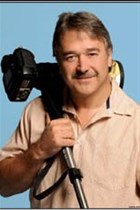





Looking back, I don't think it would have been possible to take good news photographs without a sense of timing. Back in the turbulent 80's, news photographers did not have the luxury of fancy digital cameras or attending expensive photographic courses. It was pretty much a case of being thrown in at the deep end with concrete shoes on, having to learn on the job every day and still take decent, newsworthy pictures that captured the exact moment.
If that meant taking dangerous action pictures in the townships with violence happening all around you, you simply had to keep your head and your hand steady as you clicked away, even though your heart was pounding!
Developing a good sense of split-second timing, along with improving your own photographic abilities and skills, encompasses many facets. These include being totally present in the moment, expecting the unexpected and developing a keen sixth sense.
Back in the day, knowing the limitations of your analogue camera meant you had to figure out important aspects like using composition, different angles and available light to take a good picture. Take for example, the fighter jet fly-past during Nelson Mandela's presidential inauguration.
Firstly, I had to know from which direction the jets would be flying so I could place myself in the right position. Next, I had to ensure that I had the right lenses and settings on my camera - when you have milliseconds to take a picture, there are no second chances or praying the fighter pilot will fly around one more time!
I'm not sure whether photographers are born with a sixth sense or whether they develop it along the way. However, having a good visual eye, knowing exactly what you need to photograph and applying the principle of 'forewarned is forearmed' certainly helps.
At a major political meeting years ago -involving some volatile right-wing politicians that I'd photographed before - I had a feeling that things might just heat up during the event. I put a wide angle lens on my camera and pre-focused it at one metre. Sure enough, tempers soon flared and when one irate supporter took a swing at the politician, I was there and ready as it happened. I was able to capture the exact moment on film in seconds and the picture made the front page.
So while it takes time to expand and perfect your sense of timing, here are my top eight tips that could help you develop this a bit quicker. Whether you are a news photographer or you take pictures at corporate events, the principle of fast thinking and clicking away even faster remains the same.
Some of these tips may seem obvious, but in my experience, pre-planning and preparation are vital to ensure that you can 'get in the zone'. It's the best way for a professional photographer to be completely focused without having to worry about a myriad of other things that could (and often do) go wrong.
1. Establish and clarify beforehand what photographs you need to take and most importantly, what the end result should be. For me, this means thinking through what I need to do to make the picture happen, where I need to position myself or whether I need to pre-empt something to get the desired result.
For example, if I need to take a picture of President Jacob Zuma and a pretty celebrity sharing a cocktail from two straws at a gala event, I'll try wherever possible to organise factors in my control to make it happen. If that means having to charm the barman, add suitable props or move furniture around, that's what I'll do!
2. Spend time beforehand mentally 'pre-designing' at least three or four likely photographic scenarios in your head, then set yourself and your camera up for this. As I have found this to pan out in roughly 60% of shoots, this increases my chances of getting good pictures.
3. Make sure you have all the correct photographic equipment such as lenses and cameras and that it is all in perfect working order.
4. Know your camera, all its functions and limitations backwards. This includes all the settings such as ISO (film speed) and shutter speed. You have to know how to change them without even thinking. When you have to capture the exact moment as a company CEO abseils down a new building, it goes without saying that you can't be fiddling with unfamiliar settings!
5. Check that ALL your cameras have been fully charged and loaded with fresh memory cards. I always re-check my equipment before I leave for a shoot.
6. Try to find out beforehand about the location or venue where you'll be taking pictures so you can adjust your camera settings to accommodate aspects like available lighting.
7. Always try to arrive at a shoot at least 30 minutes beforehand. That gives you some time to do a 'recce' of the venue, have a quick chat to the client and establish whether there is anything you are able to shift or change. This could be a simple thing like drawing the curtains or shifting a pot plant to enhance the picture.
8. Lastly, even though you may think you are 'going into battle' totally prepared, always remember that things don't always pan out as you'd like or expect them to, therefore, ALWAYS have a plan B!
